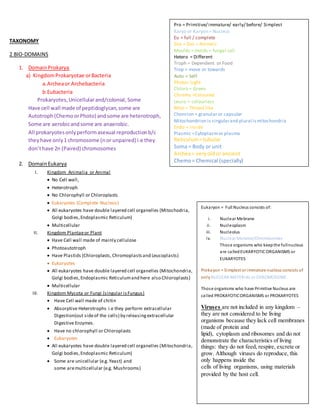
Taxonomy 1
- 1. TAXONOMY 2 BIO-DOMAINS 1. DomainProkarya a) KingdomProkaryotae orBacteria a.Archeaor Archebacteria b.Eubacteria Prokaryotes,Unicellularand/colonial,Some Have cell wall made of peptidoglycan,some are Autotroph(ChemoorPhoto) andsome are heterotroph, Some are aerobicandsome are anaerobic. All prokaryotesonlyperformasexual reproductionb/c theyhave only1 chromosome (nor unpaired) i.e they don’thave 2n (Paired) chromosomes 2. DomainEukarya I. Kingdom Animalia or Animal No Cell wall, Heterotroph No Chlorophyll or Chloroplasts Eukaryotes (Complete Nucleus) All eukaryotes have double layered cell organelles (Mitochodria, Golgi bodies,Endoplasmic Reticulum) Multicellular II. Kingdom Plantaeor Plant Have Cell wall made of mainly cellulose Photoautotroph Have Plastids (Chloroplasts,Chromoplastsand Leucoplasts) Eukaryotes All eukaryotes have double layered cell organelles (Mitochondria, Golgi bodies,Endoplasmic Reticulumand here also Chloroplasts) Multicellular III. Kingdom Mycota or Fungi (singular isFungus) Have Cell wall made of chitin Absorptive Heterotrophs i.e they perform extracellular Digestion(out sideof the cells) by releasingextracellular Digestive Enzymes. Have no chlorophyll or Chloroplasts Eukaryotes All eukaryotes have double layered cell organelles (Mitochondria, Golgi bodies,Endoplasmic Reticulum) Some are unicellular (e.g.Yeast) and some aremulticellular (e.g. Mushrooms) Pro = Primitive/ immature/ early/ before/ Simplest Karyo or Karyon = Nucleus Eu = full / complete Zoa = Zoo = Animals Moulds = molds = fungal cell Hetero = Different Troph = Dependent or Food Trop = move or towards Auto = Self Photo= Light Chloro = Green Chromo =Coloured Leuco = colourless Mito = Thread like Chonrion = granular or capsular Mitochondrion is singularand plural ismitochondria Endo = inside Plasmic =Cytoplasmor plasma Reticulum=tubular Soma = Body or unit Archea= veryoldor ancient Chemo= Chemical (specially) Eukaryon = Full Nucleus consists of: i. Nuclear Mebrane ii. Nucleoplasm iii. Nucleolus iv. Nuclear Material/Chromosomes Those organisms who keepthe fullnucleus are calledEUKARYOTIC ORGANISMS or EUKARYOTES Prokayon = Simplest or immature nucleus consists of onlyNUCLEAR MATERIAL or CHROMOSOME . Those organisms who have Primitive Nucleus are called PROKAYOTICORGANISMS or PROKARYOTES Viruses are not included in any kingdom – they are not considered to be living organisms because they lack cell membranes (made of protein and lipid), cytoplasm and ribosomes and do not demonstrate the characteristics of living things: they do not feed, respire, excrete or grow. Although viruses do reproduce, this only happens inside the cells of living organisms, using materials provided by the host cell.
- 2. IV. Kingdom Protoctistor Protista Animal Like Protoctists (Protozoa) PlantLike Protoctists (Algae) and Fungi likeProtoctists (slimmoulds and water moulds)
